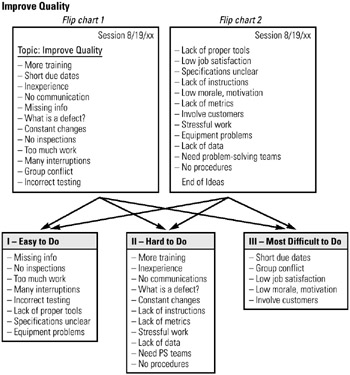Tool 48: Creativity Assessment
| AKA | N/A |
| Classification | Analyzing/Trending (AT) |
Tool description
Developed by Leo Moore, the creativity assessment technique is applied as a sorting and rating process to a long list of brainstormed ideas. It should help teams with evaluation and categorization by selecting ideas on the basis of predetermined criteria.
Typical application
-
To categorize a list of generated ideas using team-established criteria.
-
To evaluate and sort ideas into groups.
-
To screen ideas or solutions considered for implementation.
Problem-solving phase
| → | Select and define problem or opportunity |
| → | Identify and analyze causes or potential change |
| → | Develop and plan possible solutions or change |
| Implement and evaluate solution or change | |
| Measure and report solution or change results | |
| Recognize and reward team efforts |
Typically used by
| Research/statistics | |
| 1 | Creativity/innovation |
| 2 | Engineering |
| Project management | |
| Manufacturing | |
| Marketing/sales | |
| Administration/documentation | |
| 3 | Servicing/support |
| Customer/quality metrics | |
| 4 | Change management |
before
-
Brainstorming
-
Round Robin Brainstorming
-
Brainwriting Pool
-
Pin Cards Technique
-
Criteria Filtering
after
-
Consensus Decision Making
-
Cluster Analysis
-
Solution Matrix
-
Selection Matrix
-
Presentation
Notes and key points
-
The categorization scheme is often dependent on the type of data and the situation encountered.
-
Ideas can be categorized into levels of difficulty using Roman numerals for designating levels, such as:
I = easy to do; II = hard to do; III = most difficult to do
-
Other criteria can be used to determine value, importance, cost, and resources required:
I = few resources required; II = considerable resources required;
III = a great many resources required.
-
Step-by-step procedure
-
STEP 1 The team's facilitator displays flip charts of previously brainstormed ideas. See example Improve Quality.
-
STEP 2 The participants establish the criteria for assessment. In this example, the criteria are easy to do, hard to do, and most difficult to do.
-
STEP 3 The facilitator writes the respective category headings on three flip charts, and participants evaluate and organize ideas into the three categories as shown in this example.
-
STEP 4 After all ideas have been categorized, the three resulting categories I–III are reviewed and dated.
-
STEP 5 Lastly, the team presents the three idea categories to upper management for further evaluation and action.
Example of tool application
Improve Quality

EAN: 2147483647
Pages: 326